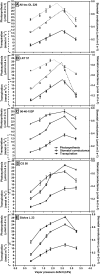Transpiration Response of Cotton to Vapor Pressure Deficit and Its Relationship With Stomatal Traits
- PMID: 30420866
- PMCID: PMC6218332
- DOI: 10.3389/fpls.2018.01572
Transpiration Response of Cotton to Vapor Pressure Deficit and Its Relationship With Stomatal Traits
Abstract
Many studies have demonstrated that the cotton in warm environments is vulnerable to water-limitations thus reducing the yield. A number of plant traits have been recommended to ameliorate the effects of water deficits on plant growth and yield. Limitation on maximum transpiration rate (TR) under high vapor pressure deficit (VPD), usually occurs during midday, is often considered as a water conservation trait. The genotypes with this trait are desirable in high VPD environments where water deficits commonly develop in the later part of the growing season. Our objective of the study was to find the genotypic variation for the trait limited TR under high VPD and also to study leaf temperature, water potential, photosynthesis, and stomatal conductance responses. Also, our objective was also to study the structural changes in the stomatal traits when exposed to long term high VPD conditions and involvement in such responses. In the present study, 17 cotton genotypes were studied for their (TR) response to various VPD environments under well irrigated conditions. Out of 17, eight genotypes limited TR after approximately 2 kPa VPD and rest of them increased their TR with increased VPD. Five selected genotypes with different TR response to increasing VPD were further studied for gas exchange and stomatal properties. All genotypes, irrespective of exhibiting limited TR at high VPD, reduced stomatal conductance, photosynthesis and water potential at high VPD of 3.3 kPa. The genotypes with limited TR modified their stomatal traits mostly on the adaxial surface with frequent and small stomata under high VPD. The genotypes with limited TR also exhibited an increase in epidermal cell expansion and stomatal index at contrasting VPD gradients to effectively balance the liquid and vapor phase conductance to limit TR at high VPD.
Keywords: cotton; gas exchange; stomata; transpiration; vapor pressure deficit; water potential.
Figures




References
-
- Aasamaa K., Sõber A. (2011). Stomatal sensitivities to changes in leaf water potential, air humidity, CO2 concentration and light intensity, and the effect of abscisic acid on the sensitivities in six temperate deciduous tree species. Environ. Exp. Bot. 71 72–78. 10.1016/j.envexpbot.2010.10.013 - DOI
-
- Aliniaeifard S., van Meeteren U. (2014). Natural variation in stomatal response to closing stimuli among Arabidopsis thaliana accessions after exposure to low VPD as a tool to recognize the mechanism of disturbed stomatal functioning. J. Exp. Bot. 65 6529–6542. 10.1093/jxb/eru370 - DOI - PMC - PubMed
-
- Ben-Asher J., Garcia A., Flitcroft I., Hoogenboom G. (2013). Effect of atmospheric water vapor on photosynthesis, transpiration and canopy conductance: a case study in corn. Plant Soil Environ. 59 549–555. 10.17221/346/2013-PSE - DOI
LinkOut - more resources
Full Text Sources

